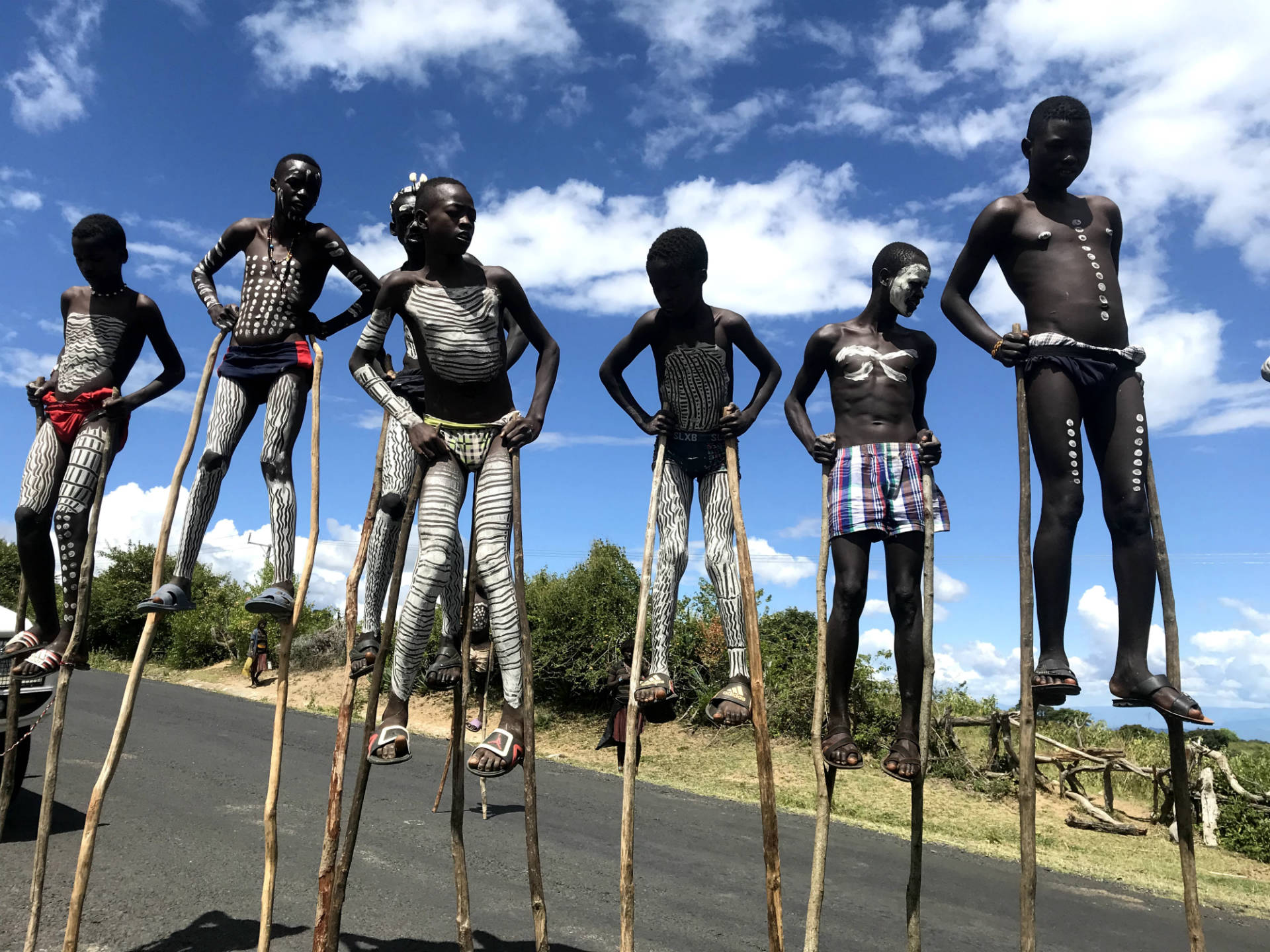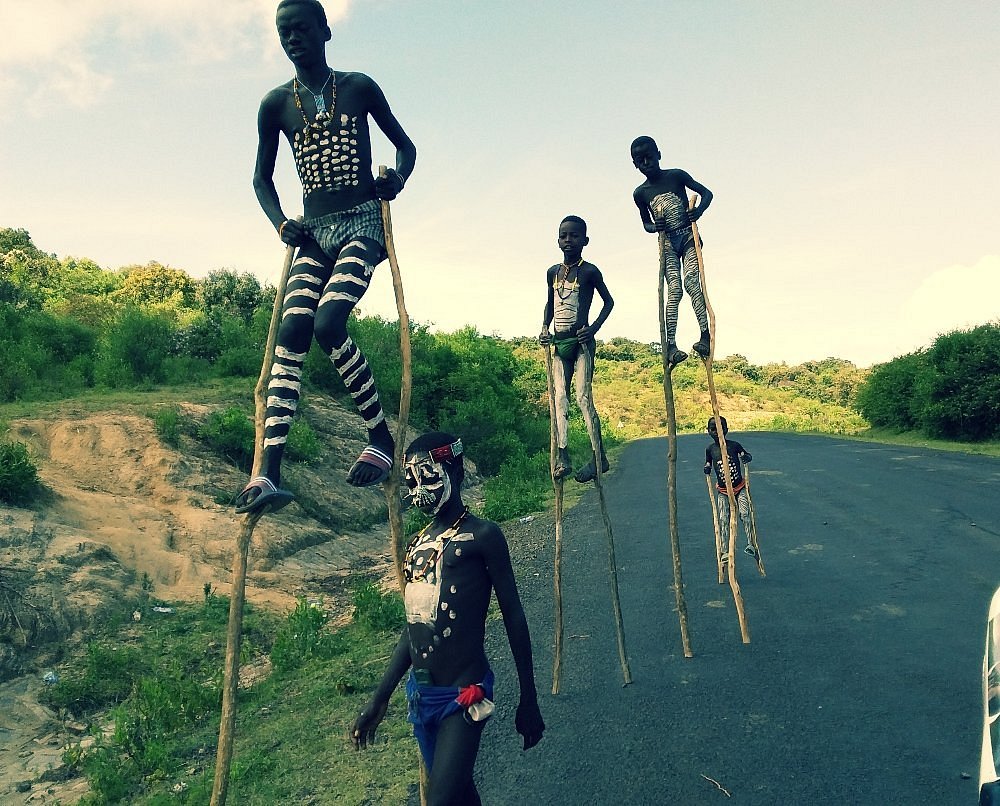Ethiopia is a cultural melting pot and a sweet tale is told about Banna tribe stilts. This is the reason behind the ‘air walking’ concept the tribesmen from this community are known for. Their bloodline traces to the Omotic ethnic group that inhabits the Lower Omo Valley, especially between the Weyto and Omo rivers. Some people identify this tribe as ‘Banya’, ‘Bena’ or ‘Benna’. There are over 47,000 Banna people whose main economic activity is hunting, pastoralism and low-scale farming. Further, some profess Islam faith while others are Christians and a monarch governs the community.
What’s interesting about them is their rich history that continues to intrigue the world in the 21st century. All this is thanks to ‘Beshitas’ – a local name referring to stilt walkers.
Table of Contents
Banna Tribe Stilts Walking Skill
There is a reason behind Banna tribe stilts cultural intrigue. Young men from this tribe walked on stilts as a mechanism to avoid attack by wild animals while herding cattle. However, this is not the only reason why stilts are common in this part of southwestern Ethiopia.

Ethiopian Banna tribe boys walking on stilts. Photo/Ethiopian Trips
Stilts-walking is a long-standing cultural tradition among community members. Unmarried young men are the carriers of this tradition popular during community festivals and rituals. A rule for Banna tribe stilts art during a ceremony is painting their bodies in white strips.
The wooden poles used to build the stilts are sourced locally. A stilt can be several meters high and moving them requires a great deal of expertise, balance, and physical strength. Amazingly, young men pull it off with amazing elegance and dexterity which is a show of strength and physical aptitude. They captivate the audience with their dexterous movements as they perform complicated footwork, dance-like motions, and acrobatic performances.
Essentially, the stilt-walking custom has numerous cultural and societal significance. For young males, it represents a transition from youth to maturity and is a rite of passage. Striking a balance on the poles and walking gracefully sends a strong message to the tribe that the boy is responsible, independent-minded, strong-willed and confident to take on life with the temerity of a lion. Moreover, these shows help to preserve cultural history while fostering a sense of pride and identity among the tribe.
Where is Banna Tribe From?
The Banna people live in southwestern Ethiopia, particularly in the Lower Omo Valley region; between Omo Rivers and Weyto. Banna language is a widely spoken language. Ideally, it is a mix of Hamar-Banna influences. Although the Banna people do walk on stilts, other factors also contribute to their popularity and cultural significance.
To begin with, they have distinctive, eye-catching traditional regalia that captivate a lot of people. Their ethnic identity is shown in the elaborate embroidery, beaded, and decorative motifs on their traditional clothes. Also, Banna people’s kindness and generosity make them popular.
What’s more is that much as Banna tribe stilts are the real deal, they are endowed with a wealth of indigenous knowledge. This includes sustainable resource management methods, farming methods, and traditional medical procedures. Researchers and environmentalists interested in maintaining traditional knowledge systems and supporting sustainable practices seek out their expertise in these fields.
Lastly, they are famous for their craftsmanship in a wide range of industries. They produce fine wood carvings, woven baskets, ceramics, and other traditional crafts that are highly prized for their creative merit.
Why Does The Bana Tribe Walk On Sticks?

Bena tribe on stilts. Photo/TripAdvisor
Banna tribe stilts are more of a cultural symbol than a safety undertaking with significance as a rite of passage for young men. Not to discount its importance against wild animal attacks. Additionally, it exhibits that a young banya man is of age to take up life on another level. Therefore; this Ethiopian tribe walking on stilts does this as a means of cultural preservation.
Tourists and academic researchers interested in the region’s varied cultural traditions have spoken widely about the stilt walking tradition. What’s more; it provides a window into Ethiopia’s rich cultural heritage and the distinctive practices of its indigenous communities.
In retrospect, stilt walking isn’t as common and pronounced as it was decades ago because a lot has changed. The shifting dynamics of modern society and civilization have toned down this practice but you will still find it during major community ceremonies.
Conclusion
Banna tribe stilt-walking tradition is an intriguing cultural custom that accentuates the strength and talent of young males. It commemorates their cultural history and carries down traditions from one generation to the next through their artistic performances. It’s a lens into the complex fabric of Ethiopia’s numerous ethnic groups and their distinctive cultural traditions.









